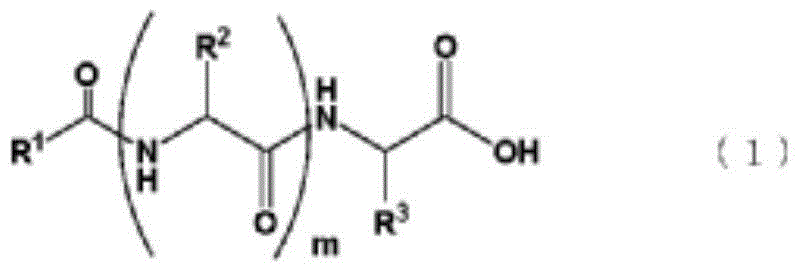Method for producing cosmetic, method for preparing gel for cosmetics, and method for reducing quantity of high-molecular thickener added to starting materials of cosmetic
A polymer thickener and cosmetic gel technology, which is applied in the field of cosmetics manufacturing, can solve the problems of increased viscosity of cosmetics, difficult cosmetic gelation, uncomfortable use of cosmetics, etc., to improve the feeling of use and reduce the amount of cosmetics. Effects of peeling and dripping, suppressing increase in viscosity of cosmetics
- Summary
- Abstract
- Description
- Claims
- Application Information
AI Technical Summary
Problems solved by technology
Method used
Image
Examples
Embodiment
[0152] Hereinafter, the present invention will be more specifically described by way of examples and comparative examples, but the present invention is not limited to the following examples.
[0153] In addition, the meanings of the abbreviations used in the following examples and the compounds used are as follows.
[0154] Gly: Glycine
[0155] His: Histidine
[0156] Carboxyvinyl polymer: Carbopol 940 (manufactured by ITO Co., Ltd.)
[0157] TEA: Triethanolamine (manufactured by Junsei Chemical Co., Ltd.)
[0158] PG: propylene glycol
[0159] CMC: Carboxymethylcellulose (manufactured by Asone Co., Ltd.)
[0160] In the following tables, "◯" indicates that gelation occurred, "×" indicates that gelation did not occur, and "-" indicates that it was not performed.
[0161] In addition, in the present invention, although eluate (solvent separation) is generated on the gel, the gel can be used for the production of cosmetics.
Synthetic example 1
[0162] [Synthesis Example 1: Synthesis of N-palmitoyl-Gly-His]
[0163] In a 500mL 4-neck flask, put 14.2g (91.6mmol) of histidine, 30.0g (91.6mmol) of N-palmitoyl-Gly-methyl ester, 300g of toluene, and add 28% methanol solution of sodium methoxide as a base 35.3 g (183.2 mmol), heated to 60°C in an oil bath and continued stirring for 1 hour. Then, it was taken out from the oil bath and left to cool to 25° C., reprecipitated with 600 g of acetone, and filtered. The solid obtained at this time was dissolved in a mixed solution of 600 g of water and 750 g of methanol, 30.5 mL (183.2 mmol) of 6N hydrochloric acid was added thereto for neutralization, and a solid was precipitated, followed by filtration. Next, the obtained solid was dissolved in a mixed solution of 120 g of tetrahydrofuran and 30 g of water at 60°C, 150 g of ethyl acetate was added, and the mixture was cooled from 60°C to 30°C. Then, the precipitated solid was filtered. The obtained solid was heated to 60° C. i...
Embodiment 1
[0164] [Example 1: Evaluation test of hydrogelation ability of carboxyvinyl polymer, TEA, N-palmitoyl-Gly-His]
[0165] Add N-palmitoyl-Gly-His synthesized in Synthesis Example 1 to a threaded tube (Maruem No.5, manufactured by Maruem Co., Ltd.) so that the concentration of N-palmitoyl-Gly-His is 0.1 to 1.0 wt% (w / w), the concentration of TEA is 0.015-0.09wt% (w / w), heated to 80-100°C using a heating block constant temperature bath (manufactured by Japan Genetics Co., Ltd.), and visually confirmed that the transparent dispersion is achieved. On the other hand, a carboxyvinyl polymer was added to a threaded tube (Maruem No.5, manufactured by Maruem Co., Ltd.) to a concentration of 0.025 to 0.15 wt% (w / w), and a heating block constant temperature bath (Japan Genetics Co., Ltd.) heated to 80°C. In the carboxyvinyl polymer in the heated state, add the TEA aqueous solution of N-palmitoyl-Gly-His in the heated and dispersed state at a weight ratio of 1:1, and stir with a vortex mix...
PUM
| Property | Measurement | Unit |
|---|---|---|
| molecular weight | aaaaa | aaaaa |
Abstract
Description
Claims
Application Information
 Login to View More
Login to View More - Generate Ideas
- Intellectual Property
- Life Sciences
- Materials
- Tech Scout
- Unparalleled Data Quality
- Higher Quality Content
- 60% Fewer Hallucinations
Browse by: Latest US Patents, China's latest patents, Technical Efficacy Thesaurus, Application Domain, Technology Topic, Popular Technical Reports.
© 2025 PatSnap. All rights reserved.Legal|Privacy policy|Modern Slavery Act Transparency Statement|Sitemap|About US| Contact US: help@patsnap.com



